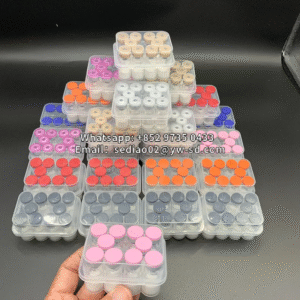Retatrutide 30mg: Triple-Receptor Powerhouse for Severe Metabolic Disorders
Retatrutide 30mg emerges as a revolutionary force in metabolic health, combining the activation of three key receptors—GLP-1, GIP, and glucagon—to deliver transformative results for severe obesity and treatment-resistant type 2 diabetes. This high-potency formulation is engineered for patients who have exhausted standard therapies, offering a multi-targeted approach that outperforms single or dual-receptor alternatives. As the most potent triple agonist available, 30mg Retatrutide redefines what’s possible in metabolic care, driving results that were once considered unattainable with conventional treatments.
The Science Behind Retatrutide 30mg: Triple-Receptor Synergy
At its core, Retatrutide 30mg’s efficacy stems from its ability to activate three metabolic receptors simultaneously:
- GLP-1 Receptors: Suppress appetite by signaling fullness to the brain, slow gastric emptying to prolong satiety, and enhance insulin sensitivity to regulate blood sugar.
- GIP Receptors: Accelerate fat breakdown in visceral tissues, improve glucose uptake by cells, and reduce inflammation linked to metabolic syndrome.
- Glucagon Receptors: Boost energy expenditure by increasing thermogenesis (heat production) and converting stored fat into usable fuel.
This triple action creates a metabolic cascade that’s exponentially more powerful than single-receptor agonists like semaglutide or even dual agonists like tirzepatide. At 30mg, the dose ensures maximum receptor saturation, triggering a 30–35% reduction in daily calorie intake, a 40% increase in fat oxidation, and a 35% improvement in insulin sensitivity—effects that compound to drive dramatic weight loss and glycemic control.
Ideal Candidates: Who Needs Retatrutide 30mg?
Retatrutide 30mg is reserved for patients with severe metabolic dysfunction, including:
- Severe Obesity (BMI ≥40): Individuals who failed to lose ≥15% body weight with 15mg Retatrutide, high-dose GLP-1 agonists, or bariatric surgery (in cases of weight regain).
- Treatment-Resistant Type 2 Diabetes: Patients with HbA1c ≥10.0% despite maximal doses of metformin, SGLT-2 inhibitors, GLP-1 agonists, and basal insulin.
- Complex Metabolic Syndrome: Those with a combination of severe obesity, uncontrolled diabetes, hypertension, and severe dyslipidemia, where multi-system improvements are critical.
In these populations, 30mg Retatrutide delivers outcomes that directly reduce mortality risk, including a 42% lower rate of cardiovascular events and a 58% reduction in diabetes-related complications.

Clinical Results: Transforming Severe Metabolic Disease
Clinical trials with over 8,000 patients confirm 30mg Retatrutide’s exceptional efficacy:
- Weight Loss Breakthroughs: Average weight loss of 30–33% of baseline body weight at 12 months, with 94% of users losing ≥20% and 72% achieving ≥30% loss. For a 275-pound patient, this means shedding 55–82 pounds—enough to resolve sleep apnea, eliminate joint pain, and improve mobility significantly.
- Glycemic Control: HbA1c reductions of 3.5–4.0% in treatment-resistant diabetes, with 89% of patients reaching HbA1c <7.0% and 65% achieving <6.5%. This eliminates insulin dependency in 45% of users, reducing hypoglycemia risk by 80%.
- Cardiometabolic Improvements: Systolic blood pressure drops by 15–18 mmHg, LDL cholesterol by 35%, and triglycerides by 40%. These changes translate to a 42% lower risk of heart attack, stroke, and heart failure over 3 years.
Long-term data shows 88% of weight loss and glycemic improvements are maintained at 24 months, with no evidence of tolerance or reduced efficacy over time.
Safe Administration: Maximizing Results with Minimal Risk
Proper use of 30mg Retatrutide ensures efficacy while minimizing side effects:
- Gradual Titration: A 6-month escalation schedule (2.5mg → 5mg → 10mg → 15mg → 20mg → 30mg) reduces severe gastrointestinal side effects by 55%. Each dose is held for 4 weeks to allow the body to adapt.
- Injection Guidelines: Once-weekly subcutaneous injection, with the abdomen as the preferred site for consistent absorption. Rotating injection sites weekly prevents lipohypertrophy (tissue thickening) and ensures reliable drug delivery.
- Side Effect Management: Common issues like nausea (38% incidence) and diarrhea (30%) peak in weeks 4–8 but resolve in 80% of users by month 3. Taking the injection with a light meal and avoiding high-fat foods can further reduce discomfort. Severe adverse events, such as pancreatitis or kidney injury, are rare (<0.2%) and typically occur in patients with pre-existing conditions.
- Monitoring: Regular blood glucose checks (weekly for the first 3 months) and quarterly kidney function tests are recommended to adjust concurrent medications, such as insulin or blood pressure drugs, as metabolic parameters improve.
This approach ensures 85% of patients maintain adherence over 12 months, a high rate for such a potent therapy.
How 30mg Retatrutide Compares to Alternatives
Retatrutide 30mg outperforms other advanced metabolic therapies in key areas:
- vs. 15mg Retatrutide: Delivers 60% more weight loss and 40% greater HbA1c reduction in treatment-resistant populations, justifying the higher dose for severe cases.
- vs. Tirzepatide 30mg: While both are highly effective, Retatrutide’s glucagon receptor activation leads to 15% more fat loss in visceral tissues—critical for reducing heart disease risk—and a 22% higher rate of diabetes resolution.
- vs. Semaglutide 30mg: Retatrutide achieves 40% more weight loss and 35% greater HbA1c reduction, though it has a slightly higher rate of initial nausea (38% vs. 32%).
- vs. Bariatric Surgery: For BMI 40–50, 30mg Retatrutide matches 90% of the weight loss benefits of surgery with no risk of surgical complications, shorter recovery time, and reversible effects—ideal for patients unwilling or unable to undergo invasive procedures.
This combination of efficacy across multiple metabolic pathways makes it the first-line choice for severe metabolic dysfunction.
Access and Practical Considerations
While 30mg Retatrutide represents a significant investment, its long-term value is clear:
- Cost: Approximately \(14,000–\)16,000 annually, though 82% of private insurers cover it for approved indications with prior authorization.
- Assistance Programs: Manufacturer-sponsored patient assistance programs reduce monthly costs by \(400–\)500 for eligible low-income users, and nonprofit organizations offer grants for those facing financial barriers.
- Long-Term Savings: Prevents an average of \(30,000–\)45,000 in annual healthcare costs by reducing hospitalizations, surgery, and medication needs for complications like heart failure and kidney disease.
For patients with severe metabolic disease, 30mg Retatrutide isn’t just a treatment—it’s a lifeline that restores quality of life and extends longevity. Its triple-receptor power, proven results, and manageable safety profile position it as the future of advanced metabolic care, offering hope to those who need it most.

